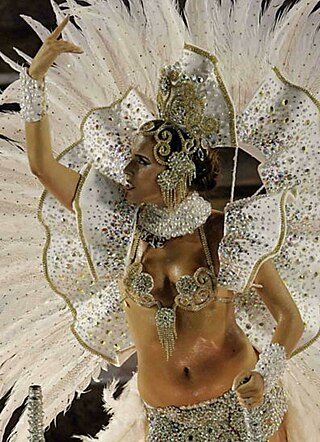
Samba, is a name or prefix used for several rhythmic variants, such as samba urbano carioca, samba de roda, recognized as part of the Intangible Cultural Heritage of Humanity by UNESCO, amongst many other forms of samba, mostly originated in the Rio de Janeiro and Bahia States.

Maria do Carmo Miranda da Cunha, known professionally as Carmen Miranda, was a Portuguese-born Brazilian singer, dancer and actress. Nicknamed "The Brazilian Bombshell", she was known for her signature fruit hat outfit that she wore in her American films. As a young woman, she designed hats in a boutique before making her first recordings with composer Josué de Barros in 1929. Miranda's 1930 recording of "Taí ", written by Joubert de Carvalho, catapulted her to stardom in Brazil as the foremost interpreter of samba.
Bossa nova is a relaxed style of samba developed in the late 1950s and early 1960s in Rio de Janeiro, Brazil. It is mainly characterized by a "different beat" that altered the harmonies with the introduction of unconventional chords and an innovative syncopation of traditional samba from a single rhythmic division. The "bossa nova beat" is characteristic of a samba style and not of an autonomous genre. The bossa nova wave became popular around the world and it helped to renew samba and to contribute to the modernization of Brazilian music.
Latin jazz is a genre of jazz with Latin American rhythms. The two main categories are Afro-Cuban jazz, rhythmically based on Cuban popular dance music, with a rhythm section employing ostinato patterns or a clave, and Afro-Brazilian jazz, which includes samba and bossa nova.

The culture of Brazil is primarily of Western extraction, being derived from Portuguese culture, as well as the cultural mixing that occurred between the Indigenous peoples, Portuguese colonizers and Africans primarily during the brazilian colonial period. In the late 19th and early 20th centuries, Brazil received a significant number of immigrants, primarily of Portuguese, Italian and Spanish origin, which along with smaller numbers of Germans, Austrians, Arabs, Japanese, Poles and Ukrainians gave a relevant contribution to the formation of regional cultures in Brazil, and thus contributed to its current existence as a plural and racially diverse society.
Samba is a lively dance of Afro-Brazilian origin in 2/4(2 by 4) time danced to samba music.
Latin rock is a term to describe a subgenre blending traditional sounds and elements of Latin American and Hispanic Caribbean folk with rock music. However, it is widely used in the English-language media to refer any kind of rock music featuring Spanish or Portuguese vocals. This has led to controversy about the scope of the terminology.

Axé is a popular music genre originated in Salvador, Bahia, Brazil in the 1980s, fusing different Afro-Caribbean genres, such as marcha, reggae, and calypso. It also includes influences of Brazilian music such as frevo, forró and carixada. The word Axé comes from the Yoruba term àṣẹ, meaning "soul, light, spirit or good vibrations". Axé is present in the Candomblé religion, as "the imagined spiritual power and energy bestowed upon practitioners by the pantheon of orixás". It also has ties with the Roman Catholic Church and the Lenten season, which represents the roots of Bahian Carnival.

The Carnival of Brazil is an annual festival held the Friday afternoon before Ash Wednesday at noon, which marks the beginning of Lent, the forty-day period before Easter. During Lent, Roman Catholics and some other Christians traditionally abstained from the consumption of meat and poultry, hence the term "carnival", from carnelevare, "to remove meat."

Black Orpheus is a 1959 romantic tragedy film directed by French filmmaker Marcel Camus, and starring Marpessa Dawn and Breno Mello. It is based on the play Orfeu da Conceição by Vinicius de Moraes, which set the Greek legend of Orpheus and Eurydice in a contemporary favela in Rio de Janeiro during Carnaval. The film was an international co-production among companies in Brazil, France and Italy.
Samba rock is a Brazilian dance culture and music genre that fuses samba with rock, soul, and funk. It emerged from the dance parties of São Paulo's lower-class black communities after they had been exposed to rock and roll and African-American music in the late 1950s.
Samba de Gafieira is a partner dance to various Brazilian samba musical rhythms. Unlike street and club forms of Brazilian samba, it evolved as a ballroom dance.
Ethno jazz, also known as world jazz, is a subgenre of jazz and world music, developed internationally in the 1950s and '60s and broadly characterized by a combination of traditional jazz and non-Western musical elements. Though occasionally equaled to or considered the successor of world music, an independent meaning of ethno jazz emerged around 1990 through the commercial success of ethnic music via globalization, which especially observed a Western focus on Asian musical interpretations. The origin of ethno jazz has widely been credited to saxophonist John Coltrane.
Brazilian hip hop is a national music genre in Brazil. From its earliest days in the African-Brazilian communities of São Paulo and Rio de Janeiro, the genre has grown into a countrywide phenomena. Rappers, DJs, break dancers and graffiti artists are active across the complete spectrum of society blending Brazil's cultural heritage with American hip hop to form a contemporary musical fusion.
Viral means "relating to viruses".

Dorian Corey was an American drag performer and fashion designer. She appeared in Wigstock and was featured in Jennie Livingston's 1990 documentary Paris Is Burning.

Social contagion involves behaviour, emotions, or conditions spreading spontaneously through a group or network. The phenomenon has been discussed by social scientists since the late 19th century, although much work on the subject was based on unclear or even contradictory conceptions of what social contagion is, so exact definitions vary. Some scholars include the unplanned spread of ideas through a population as social contagion, though others prefer to class that as memetics. Generally social contagion is understood to be separate from the collective behaviour which results from a direct attempt to exert social influence.
Jaiva, Township jive (TJ), Soweto jive, Soweto sound or Soweto beat is a subgenre of South African township music and African dance form that influenced Western breakdance and emerged from the shebeen culture of the apartheid-era townships.
Kim Aviance is a performance and visual drag artist, and nightclub hostess from the voguing and ballroom House of Aviance. She is a classically trained dancer and musician, and one of New York City's nightlife personalities. She is deemed a "New York nightlife queen", and has won numerous awards in the ball culture world. Aviance is a gender-non-conforming, and trans appearing.
Kalfou Danjere is an album by the Haitian band Boukman Eksperyans, released in 1992. The title track, which translates to "Dangerous Crossroads", was banned in Haiti for its alleged subversive qualities. "Nwel Inosan" was also banned.








